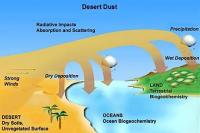- Use environmental data and themes to help your students apply mathematics to real-world problems. Assign environmentally-themed math problems, analyze data such as population figures, land use statistics, and pollutant levels, use data to draw inferences about changes in population and natural resource consumption, and have students explain the impacts of their analysis. Use the search function to the right to explore other ways to use environmental data in your classroom.
- StoryPosted bycgray3onFebruary 1, 2011
The amount of dust in the Earth's atmosphere has doubled over the last century, according to a new study; and the dramatic increase is influencing climate and ecology around the world.
Posted in: - ResourcePosted byAnonymousonMarch 24, 2010
In this lesson, students discover water and energy connections by learning how sources of energy require substantial amounts of water and how energy is used in the process of providing tap water to millions of homes.
Posted in:
Latest in this Subject
View more News, Resources , Professional Development, Grants, Success Stories
- ResourcePosted bycaitlineonJuly 1, 2011
In this lesson plan from National Geographic Xpeditions, students learn about the varying sizes of ocean waves, what causes the variation and where to find giant waves. Students learn the parts of a wave and discuss wave height, wavelength and wave period. They experiment with creating waves on National Geographic's online Wave Simulator and discuss how geography affects waves.
- ResourcePosted bycaitlineonJuly 1, 2011
Waves, Wetlands, and Watersheds is a classroom and community activity guide for teachers that addresses issues such as endangered species, marine debris, coastal geology, water use and much more. It is carefully aligned to the California State Science Content Standards for grades 3 through 8 and includes "Community Action" lessons adaptable for all ages up to and beyond 12th grade.
- ResourcePosted bycaitlineonJuly 1, 2011
This activity guide from the Shedd Aquarium provides teachers with a resource for incorporating the study of aquatic science, and specifically coral reefs, into their existing curricula. The guide is appropriate for grades 3-5 and aligns with Illinois Learning Standards in English Language Arts, Mathematics, Science and Social Science as well as National Science Education Standards.
- ResourcePosted bymedudaonJuly 1, 2011
PULSE is an interdisciplinary curriculum. It is designed to improve life science literacy by providing lessons for core high school subjects that address environmental health and biomedical research. These topics are equally relevant and motivating within science classrooms and also in those of geography, language arts, government, world and American history, and mathematics classes.
View resource - ResourcePosted bymedudaonJune 30, 2011
Cluster Busters is a unique science curriculum in which students research disease clusters that might be induced by environmental toxicants. In the process, students utilize a range of skills, draw from various academic subjects, and learn the issues and processes of disease cluster investigation. The game introduces the concepts of epidemiology, risk assessment, and toxicology.
View resource
Do you know of a resource that you think other teachers should know about?
Share your resource!



